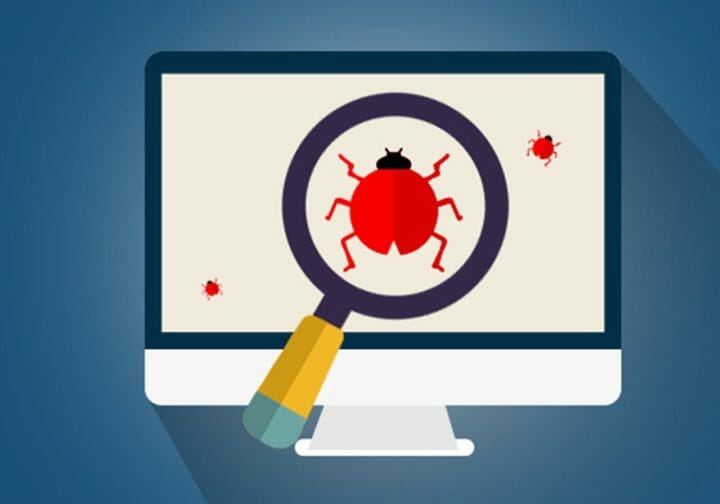42 Different Types Of Testing In Software : The Complete Guide
Software testing is the process of evaluating a software program for defects or errors. Different types of testing can ensure a smooth running and bug-free system. This post will cover several types of tests and how they work to find errors more efficiently than other tests.
Let’s get started.
What is software testing?
Software testing is the process of verifying that software meets its requirements and works as intended. Software testers use various methods to test software, including manual testing, automated testing, and penetration testing.
Manual testing is the most common type of software testing and involves testers manually doing tests on the software. Automated testing uses automated tools to test the software.
Penetration testing on the other hand involves trying to hack into the software to find security vulnerabilities.

Types of software testing
Software testing is a significant part of software engineering. No matter how good a programmer you are, there will always be a certain degree of uncertainty in your work. Bugs and errors are an unavoidable part of software development. This is why software testing is so important.
There are various types of software testing, each with its own advantages and disadvantages. The most common types of software testing include:
Accessibility Testing
Accessibility testing ensures that the software is accessible to people with disabilities. This type of testing includes visual, auditory, and physical impairments tests.
Accessibility testing ensures that people with disabilities, seniors, and other customers who have special requirements can use the system. For example, if a person is colorblind, it must be ensured that colors are properly differentiated to use the system easily.
The only drawback of accessibility testing is that it is often time-consuming and expensive.

Beta Testing
Beta testing is a type of software testing that occurs when the software is released to a limited audience outside of the developers to find and fix bugs. Beta testing is often the final phase of software development and occurs after alpha testing.
Beta testing aims to find and fix as many bugs as possible. New bugs may be fixed and features added based on feedback from beta testers to ensure the highest quality of a final release.
Depending on the software’s purpose and usage, individuals may become beta testers themselves. Beta testing can also occur in open source projects, where anyone can test pre-release versions of the software.
The testers provide feedback to the open-source community on what can be improved before the final version of the software is released.
Alpha Testing
In the software development process, alpha testing is a type of black-box testing performed by users/developers/software testers before the software goes into beta testing. Alpha testing aims at finding any bugs in the program so they can be reported and repaired.
The word “alpha” comes from the first letter of the Greek alphabet, which indicates the first phase of development.
The main purpose of alpha testing is to eliminate any obviously show-stopping errors that would prevent users from performing crucial or central tasks. For example, with an e-commerce website, the critical path items could include making a purchase and checking out as a new user.
Back-end Testing
Back-end testing is used to ensure that the back-end systems and databases are working properly. This type of testing is usually done by a separate team than the one that performs unit and integration testing. It can be automated or manual.
Back-end testing is used to ensure that the back-end systems and databases are working properly. This type of testing is usually done by a separate team than the one that performs unit and integration testing. Back-end testing can be automated or manual.
Automated back-end testing is a method that allows the execution of a series of predefined events and checking the response.
An automated back-end test may check that databases have been created, data has been inserted correctly, indexes are built properly and working as expected, etc. It could also try to execute all transactions available on a website or use scripts to simulate user activity.
These tests can be run on a schedule, and they can be used to verify the environment before every deployment. Manual back-end testing is a more detailed form of testing that manually tests each process and verifies the results.
This type of testing is often used to troubleshoot issues that may have been identified in automated testing. It can also be used to validate the results of automated tests.

Backward Compatibility Testing
Backward compatibility testing is the process of verifying that a software system or application functions correctly when used with older versions of the same system or application.
This type of testing is important for ensuring that users who upgrade to a new version of a software system can still use the older versions without experiencing any problems.
Backward compatibility testing is typically performed as part of a software system’s acceptance testing process. It can be used to verify the correct behavior of the software system when interacting with other systems and its ability to handle data and input formats from older versions.
Black Box Testing
Black box testing is done without looking into the software’s code. The tester will feed input data to the program and then observe its output behavior.
The tester acts as an “external user” who uses the application as a consumer. This type of testing is normally associated with classical functional testing of software. Still, it can also refer to stress testing – where the intention is to test whether a system or component can withstand unusually heavy, large-scale, or continuous stress.
A black box tester is not concerned with the program’s internal workings. All they are interested in is how the program responds to input data.
Boundary Value Testing
Boundary value testing tests possible inputs on the edge of what is considered valid data for a parameter such as length, range, and precision. This type of testing includes tests for the minimum and maximum values.
The main advantage of boundary value testing is that it can help detect problems at the edge of what is considered valid data. This can help increase the quality level of software by increasing stability, reliability, and usability.

Branch Testing
Branch testing is another type of software testing that can find bugs in software. It is a type of white-box testing that tests individual branches of code. This testing is useful for finding errors that may only occur when a particular code branch is executed.
Branch testing can be used to find errors in the code, but it can also be used to find errors in the logic of the code. It is often used to test complex algorithms. By testing individual branches of an algorithm, you can see if the algorithm behaves as expected.
Acceptance Testing
Acceptance testing is done after the developers have completed the code and into production. During acceptance testing, a group of users tests the software to see if it meets the requirements in the SRS document. Acceptance testing is also referred to as user acceptance testing (UAT).
Acceptance testers have access to a staging area that contains a complete or nearly complete version of the software for testing purposes. However, unlike Alpha testing, users only test features that have been implemented and reported by the developers.

Ad-hoc Testing
Ad-hoc testing is the third type of software testing and is done when there is a need to test something specific, such as a new feature or a bug. During ad-hoc testing, testers use whatever tools and techniques are available to them to test the software.
The main advantage of ad-hoc testing is that it allows testers to test specific items quickly and easily. This type of testing is also very flexible, making it ideal for testing new features or bugs.
Comparison Testing
Comparison testing is used to compare the performance of two or more different software implementations. This type of testing can determine whether there is a difference in performance between the different implementations, and if so, which implementation is faster or produces better results.
Comparison testing can also be used to compare the functionality of two or more different software implementations. It enables developers and quality assurance personnel to know whether they provide their users with the most efficient program possible. This testing can prove to be extremely useful in the future when it comes time to decide which version of a piece of software should be used.
Compatibility Testing
Compatibility testing is testing where users test the compatibility of an application or system with other software, hardware, or operating systems. This type of testing can identify and isolate compatibility issues before release.
Crowdsourced compatibility testing is often done through online platforms that allow users to submit information about their environment for use by other users. Users on the platform may also submit test logs, screenshots, and detailed reports of any issues they experience with your application or system.
Issues that are identified through compatibility testing can be used to inform development teams about the need for code changes. It can give developers access to unique environments to verify their work.

Component Testing
Component Testing is sometimes called Unit Testing. It is performed on individual software components or units rather than the whole system. This means that component testing occurs at a level below that of integration testing (described below).
As with any form of testing, input is taken from the client (the person commissioning the work) and used to determine what testing is to be done. This may take the form of what was specified or may include changes made during development.
It is possible to combine component testing with integration testing if the components are delivered ready for installation into the whole system – this is called “Big Bang” Testing.
Components of a system do not have to be produced specifically for the system in question. Generic components may be used, provided they satisfy any specific requirements for security, safety, performance, etc.
End-to-End Testing
End-to-end testing is software testing that tests the entire system from start to finish. This type of testing is usually done after unit testing and integration testing. End-to-end testing ensures that all system components are working together as intended.
End-to-end tests are usually either pass/fail tests or performance tests. The purpose of end-to-end testing is to detect problems that would not be found through other types of testing because these kinds of tests include many components. These kinds of tests are usually more complex than unit and integration tests. They also take longer to run.
The tests should finish quickly and provide feedback to the developer on whether or not the application is performing as it should (speed, function, and stability). If these tests take too long to complete, they will not be run as often, and their purpose will not be fulfilled.
Equivalence Partitioning
Equivalence partitioning is done to test for inputs in the same equivalence partition. An equivalence partition is a set of possible values that only one value from each equivalence partition can produce a critical result.
The whole idea of equivalence partitioning is to divide the input domain into different partitions where each part behaves similarly under the same conditions.
Equivalence partitioning can be done by either specifying boundaries for values or using a table to represent all possibilities. When using a table, you need to consider whether it is better to use one large table or multiple small tables.
If you have a lot of input values, it might be better to use smaller tables so that the tester can more easily keep track of them. However, if the input values are relatively small, a large table is probably more efficient.

Exploratory Testing
Exploratory testing is done without following a formalized plan or test design technique. It includes general software tests performed during the early stages of development to assess the quality of the software.
The purpose of exploratory testing is to find defects and problems in the software. It helps to identify what needs to be tested in more detail and can also help to prioritize which tests should be run first.
Exploratory testing is often done by a tester familiar with the software and the system under test. The tester is free to explore the system and test it in any way they see fit.
Black Box Testing
Black box testing is a software testing method that examines the functionality of an application without looking at the internal code or structure. This type of testing is done by testers who do not know how the application works, only what inputs and outputs are expected.
Black box testing is often used to test applications already in use. It is a cost-effective way to ensure that functionality has been maintained throughout the life of an application. Black box testing is generally done by software testers, not users or customers.
White Box Testing
White box testing, also known as clear box testing and transparent box testing, is a method of software test design where test cases are derived from the specifications of the software component being tested.
The tester chooses inputs to exercise paths through the code and determines the appropriate outputs. This is analogous to testing copper wire by connecting batteries to it, applying a voltage at various points along its length, and measuring the resulting current at its output.
White box testing can be applied during all software development life cycle phases. It can be used in conjunction with black-box testing; white box testing typically tests internal structures or workings of an application, while black-box testing will test their functionality. This is helpful when unit-testing (white-boxing) components are not exposed to the outside world by other components.

Functional Testing
Functional testing is a type of black-box testing that bases its test cases on the specifications of the software component. Functional testing verifies that a particular function or feature of a system works properly and is often included in regression testing. It is also referred to as black-box testing because the system’s internal workings are not examined.
In functional testing, test engineers create test cases by describing a software component’s input and output conditions. They then execute these tests to verify that the component behaves as expected.
Non-Functional Testing
Non-Functional Testing is a software testing approach that ensures the non-functional requirements remain satisfied. This is in opposition to functional testing, ensuring all functional requirements remain satisfied.
Non-functional testing is often used in conjunction with functional testing to ensure all system requirements are met. This testing can be done at any time during the software development life cycle but is typically performed near the end of the project when most of the system’s functionality is implemented.
Graphical User Interface (GUI) Testing
GUI testing can be performed manually by visually verifying interface behavior or recording the actions performed on the interface into a test script. It can be time-consuming to automate functional GUI testing, but the benefits include repeatability and the ability to test across multiple platforms.
One common type of GUI testing is verifying that all interface elements are present and functioning as intended. This includes buttons, icons, text fields, and other elements. Another common task is verifying that input and output are properly formatted and that the application responds as expected.
GUI testing is an important part of ensuring a quality user experience. It must be performed along with unit tests, integration tests, and other software testing to ensure that everything functions as expected.
Gorilla Testing
Gorilla software testing is a type of black-box testing. That means that the tester doesn’t have any knowledge of the system’s internals to test.
The approach is relatively simple. We create more scripts that will generate a sequence of user inputs that should cover as many use cases as possible. We then run these scripts against the system under test and look for errors.
The beauty of gorilla software testing is that it can test very complex systems. In addition, by using automation techniques such as data-driven testing and parameterized testing, we can significantly reduce the amount of time it takes to test a system.
Best of all, gorilla software testing is very reliable. By running the same tests repeatedly, we can be sure that any errors that are found are real errors and not a result of chance.
Happy Path Testing
Happy Path Testing, also known as “the happy path,” is a technique used in software testing to ensure that the most important and common use cases are checked thoroughly. It is the testing method most often used in organizations, as it makes use of the simplest techniques and can be completed with the least effort.
The name happy path originally came from the idea that the simplest and most common use cases should be tested as a “happy path – the path of least resistance.” This means that the tester should assume that everything is working and only test the most basic use cases.
Happy Path Testing is not a replacement for other types of testing but should be used in conjunction. It is beneficial for regression testing, as it is a quick and easy way to ensure that no new bugs have been introduced into the system.
Incremental Integration Testing
Incremental integration testing tests a system as it is being developed. This type of testing is done by creating a working version of the system and then adding small pieces until the software system is fully developed.
Install/Uninstall Testing
Install/uninstall testing is a method of determining the health and stability of your app during the initial launch or upgrade by attaching custom hooks to monitor installation or uninstallation events. Doing so helps ensure that your app is installed and removed without any errors, crashes, or unexpected behavior.
Integration Testing
Integration testing involves testing a system as it is being developed. This type of testing is often used to test how well software components work together.
Load Testing
Load testing is the process of putting pressure on a system or application to see how it responds. This type of testing can be used to determine how well a system stands up to high rates of traffic or other types of stress. Load testing should not be confused with performance testing, which measures how well a system performs under load.
Several different commercial and open-source tools can be used for load testing. One popular tool is JMeter, which is used to test web applications. JMeter can be used to simulate a large number of users accessing a website or application simultaneously. Other popular tools include Apache Bench and LoadRunner.
When developing a load test, it is important to ensure that the parameters are realistic and that the system doesn’t crash or become unusable. This includes setting the number of users, the length of time for each test, and other factors.
Monkey Testing
Monkey testing is software testing where random input is generated and sent to the system under test. This is done to generate unexpected results and identify potential areas of failure.
The Monkey testing tool is a Java application that can generate random input. It simulates a person sitting at a keyboard and abusing your application by randomly doing things.
Mutation Testing
Mutation testing is the twenty-ninth type of software testing. It is used to test how well a system handles changes to its source code. This type of testing is often used to ensure that changes do not have any harmful side effects or affect the system’s intended behavior.
Negative Testing
Negative software testing is the process of testing a piece of software for defects. However, this type of testing is not as simple as it sounds, as you can’t just apply the same methods and principles that you would use for positive software testing — the process of testing a piece of software for correct operation.
Performance Testing
Performance testing is verifying how a system responds to different loads. This type of testing identifies and corrects performance problems before release. Performance tests measure the system’s responsiveness under normal conditions, also known as steady-state or endurance testing.
Performance testing is used to evaluate how well the system meets its performance objectives in production. The specific objectives vary from system to system. Still, they may include measures such as the number of transactions per second that the system can handle, the response time for various transactions, or the transaction throughput that can be handled in a given time period.
Performance measures responsiveness that the system demonstrates when it is under load. This includes factors such as how fast the system can respond to requests, how much work it can do in a given time period, and how consistently and reliably it can meet or exceed performance objectives.
Recovery Testing
When it comes to software testing, “recovery” is often used to restore a system or data to a previous state. This is a common objective sought in various types of tests that validate the recoverability of software or data after a crash, an exception, or loss of power.
There are several different ways to test for recoverability, but all share the goal of verifying that the software or data can be restored to a working state. One common approach is to cause a failure or unexpected condition and then verify that the software or data can be recovered to a working state.
Software recovery testing can be difficult because it requires putting the software through various stress test scenarios. Each scenario is designed to test a different part of the software and its recovery ability.
Regression Testing
Regression software testing is one of the most important aspects. This type of testing helps ensure that changes or updates made to the software don’t impact any other functionality or processes.
It can be done manually, but it is often better to use regression software testing tools. These tools can automate the process of regression testing, making it faster and more efficient.
Risk-Based Testing (RBT)
Risk-Based Testing (RBT) is a software testing methodology that helps prioritize tests according to the risks they aim to mitigate. RBT is often used with other methodologies, such as Black-box Testing and White-box Testing.
The goal of RBT is to prioritize test cases to maximize the chance of finding bugs. The priority of test cases should be decided according to the risk they aim to mitigate. The risk is defined as the probability of failure to meet a requirement (or set of requirements) expressed as the product of the probability of a fault and the impact.
RBT can be used in both manual and automated testing. It is often used early in the software development life cycle and can be used on individual requirements or the entire system.
Sanity Testing
Sanity testing is performed to confirm that the software is doing what it should be doing at every stage of its processing. Sanity checking allows testers to confirm whether data meets specified criteria, is within range, or is otherwise fit for use in the next processing phase.
Security Testing
Security testing is used to identify ways that unauthorized individuals or systems could access the system being tested. There are two main types of security testing: penetration and vulnerability.
Penetration tests are designed to uncover vulnerabilities that attackers can exploit, while vulnerability tests are designed to find security holes that could be used in a malicious attack.
Smoke testing is used to determine if a new build or release is ready for further testing. Smoke testing is usually done on a limited number of features and takes a concise amount of time to complete.
Static Testing
Static testing involves assessing a software artifact without running it. Static testing is usually done by examining the source code or design documents.
Stress Testing
Stress software Testing is a type of testing that pushes the software beyond its normal operational capacity to determine what happens when the system is stressed.
When you run stress tests, you put your application under abnormal strain and monitor its behavior to uncover any defects in the software.
Due to stress testing being a load of the software to its full capacity, it is also known as load testing.
Here are some of the goals of stress testing:
- Identify the maximum load that your application can handle
- Identify any unexpected behavior under high load.
System Testing
System software testing is verifying and validating the functionality, performance, and reliability of system software. System software comprises the operating system and all software built on it. This testing can be done before or after product development but is typically done before a product is launched.
Usability Testing
Usability testing is a form of software testing that ensures a software product is usable and meets people’s expectations. A variety of people uses a software product for a variety of reasons. A usability test aims to discover if all people can use the product.
Usability testing is a form of subjective evaluation, where the subject matter experts’ opinions about a product are gathered and analyzed to see if the product is easy to use. The experts are usually the people who will be using the product daily.
The main objective of the testing is to find the usability problems in the software product that will interfere with user productivity or satisfaction.
White-box testing
White-box testing is a form of software testing conducted from the perspective of the code itself. This type of testing can be used when there is a requirement for an internal structure or flow within the code to be tested.
White-box testing requires familiarity with the programming language and the internal structure or flow of the software.
It is usually performed by QA engineers and programmers, as it requires programming skills and knowledge of the system.
Wrapping it up
We hope this post has given you a better understanding of the many different types of testing in software. Whether you’re an individual developer or part of a larger team, it’s important to know your role and use these techniques for maximum effectiveness.
What other types of software testing do you know? Let us know in the comments below.











